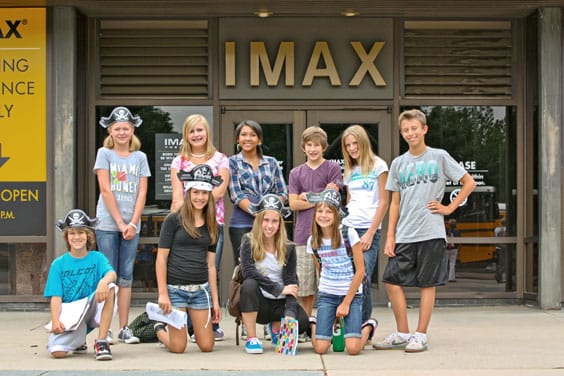RHMS students explore the world of piracy

RHMS seventh and eighth grade students got in the swashbuckler spirit when they attended the Real Pirates exhibit last month at the Denver Museum of Nature and Science.
Article by Kathy Dunker with photos by Kelly Corr
In a combined field trip for Rocky Heights Middle School (RHMS) seventh and eighth graders, the students explored the “Real Pirates” exhibit at the Denver Museum of Nature and Science on August 15, 16 and August 19. The exhibit enhanced the seventh grade social studies unit about world geography of the Eastern Hemisphere as well as the eighth grade unit on American history.
It was somewhat of a scramble to get the field trip organized with the first day of school being August 8 and the exhibit closing later that same month, along with the unique challenge of including two full grade levels of students. Sharon Majetich, eighth grade social studies teacher and department chair, said, “It was an amazing feat to get the curriculum covered in this cross teaming and cross curricular field trip. I’m sure the Museum was shocked to have 900 RHMS students all attend in one week!”
The “Real Pirates” exhibit contained artifacts from the slave ship, Whydah, which sailed out of London, England, for the first time in 1715. Slave ships were perfect targets for pirates since they were easy to maneuver, unusually fast, and well armed. In 1717, after the Whydah’s human cargo from Africa was unloaded in the West Indies, the ship was captured by the notorious pirate Sam Bellamy and his crew of ordinary seamen, free black men, political dissidents, escaped slaves, indentured servants, Native Americans, and runaway plantation workers.
Williamson remarked, “Students were able to see over 200 artifacts that are approximately 300 years old. Favorite artifacts were the massive Whydah bell and the many cannons. There have been over 60 cannons found to date!” Seventh graders are also studying modern-day pirates who operate off the coast of Somalia, Africa, allowing students to make connections between the two groups.
“The 8th grade connection to the Triangle Trade of the Atlantic and the fact that the Whydah was first a slave ship fit perfectly into our grade level expectations,” social studies teacher, Holly Spurlin, commented. “It was a wonderful exhibit for touching on so many standards. The technology required to locate and salvage the ship was amazing. John Kennedy Jr. worked with Barry Giffords early on to locate the wreck [which had] prior thought to have been a possible legend and not reality. They even found Kennedy’s compass hooked on a pile of cannons that have since been recovered!”